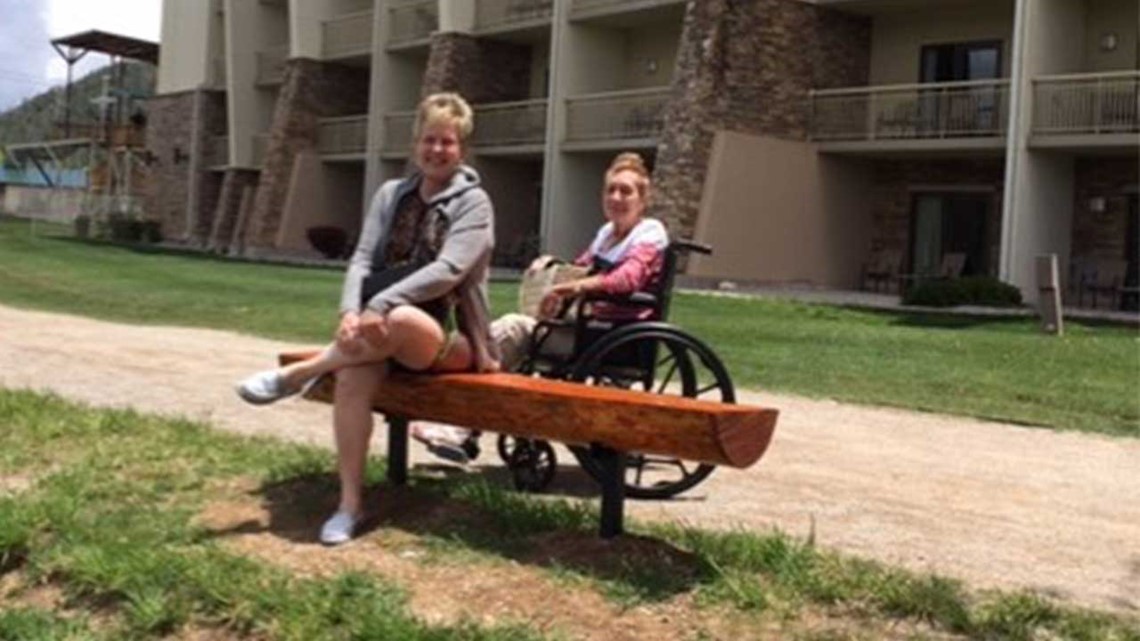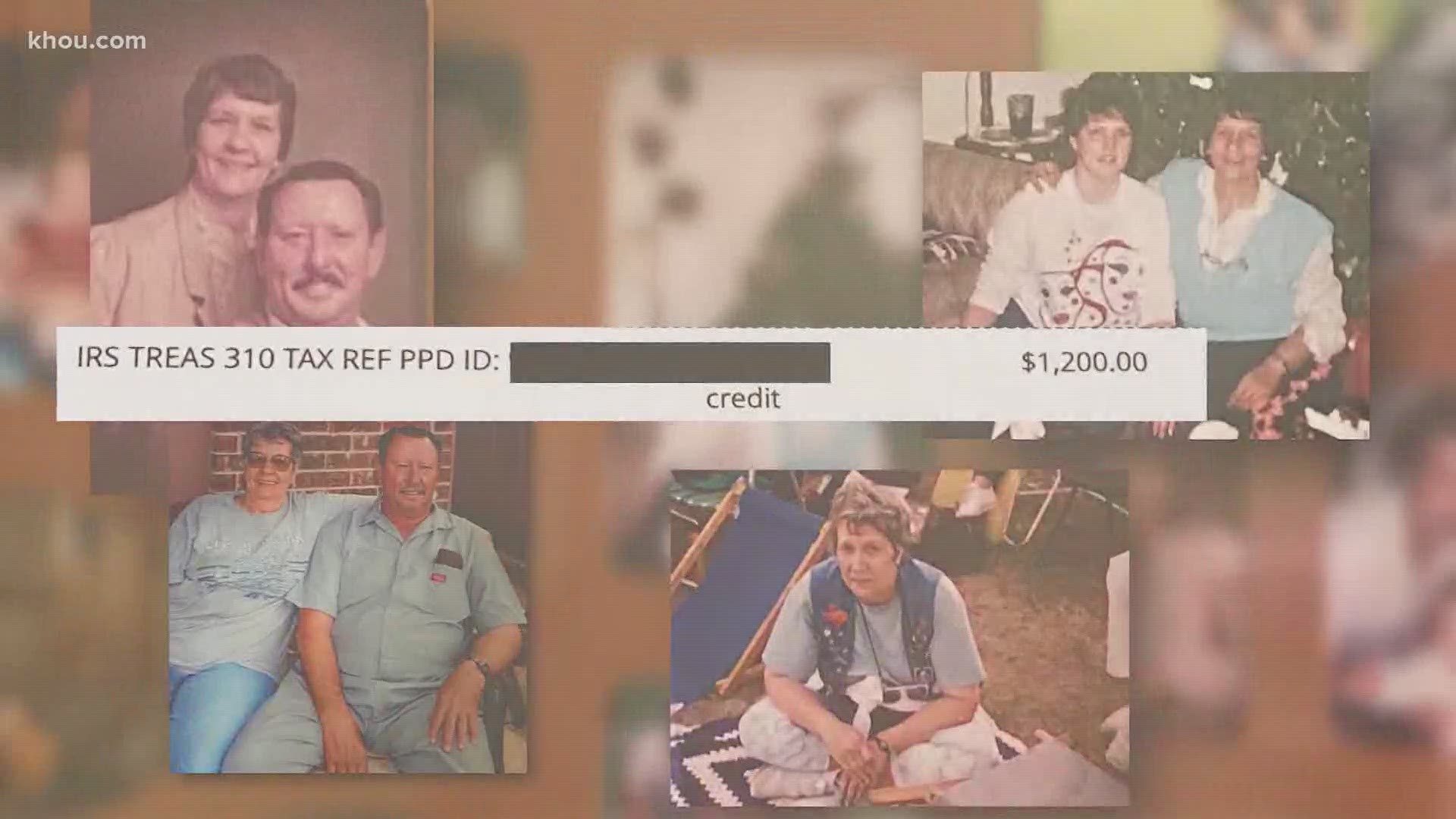HOUSTON — Dead Americans are receiving payments from the CARES Act, intended to help people struggling to survive during the COVID-19 economic crisis.
The scope of the problem and what people should do with the money is not clear, as the U.S. Treasury Department did not respond to KHOU 11 emails. We reached out to the IRS as well. At the time of publication, the agency has not gotten back to us.
Natalie from Sugar Land wants to give this money back.
For privacy reasons, she asked KHOU 11 only to use her first name.
“I don't want it, you know, I'm sure there's people out there that need $1,200 bucks at this time. I mean, it's rough out there,” she said.
According to the death certificate, Natalie lost her mom Loretta two years ago in May.
“My mom, it's hard to put into words,” Natalie said. “She lived with me for the last four years of her life. I spent the most wonderful years with her. Just an all-around great mother. And I miss her dearly.”
The Sugar Land woman told KHOU 11 when she saw four CARES Act deposits in her bank account, it took her time to figure out why there were that many.
“We were shocked,” Natalie said. “It took me a good day to figure out what it was.”


Natalie said she was the executor of her mom’s affairs and filed her last taxes in 2019.
“So, when we got the stimulus, it just came straight to my checking account for her,” she said.
After some research, Natalie read she’s not the only one receiving her deceased loved one’s money.
“You would think that there's a button you can push to send out stimulus checks to everybody, but the deceased,” she said. “When she passed, Medicare knew immediately. Actually, they took social security, whatever was left for the remainder of the year, they took it out of her checking account within three weeks.”
In an e-mail, the Social Security Administration told KHOU, it keeps a file of deaths in the United States.
Social Security’s Death Master File (DMF)- There are two versions: the “Public” file and the “Public plus State” file. Here are the contents and sources and how SSA shares each.
Contents and sources of data – Public file
- The Public file contains all deaths reported to SSA from sources other than States.
- Sources of death data on the Public file are family members, funeral homes, Federal agencies (Centers for Medicare & Medicaid Services, Veteran’s Benefits Administration, etc.), postal authorities, financial institutions and internal sources from SSA’s payment records. The file contains both beneficiary and non-beneficiary death records, and verified and unverified data.
- Section 205(r) of the Social Security Act prohibits SSA from disclosing State records we receive through our contracts with the States, except in limited circumstances. Therefore, we cannot legally share those State records on the Public file.
- As of December June 2019, the Public file contained over 101million records.
- The data elements in the Public file include the Social Security number, date of birth, date of death, first, middle and last name and a proof code.
Contents and sources of data – Public plus State file
- This file contains all death data reported to SSA. Sources of death data in this file are States, family members, funeral homes, Federal agencies (Centers for Medicare & Medicaid Services, Veteran’s Benefits Administration, etc.), postal authorities, financial institutions and internal sources from SSA’s payment records. The file contains both beneficiary and non-beneficiary death records and verified and unverified data.
- As of June 2019, this file contained over 125 million records. Each year SSA adds almost 2.9 million records to this file.
- The data elements in the Public plus State file include the Social Security number, date of birth, date of death, first, middle and last name and a proof code.
SSA shares contents of Public file
- SSA shares the contents of this file with the U.S. Department of Commerce’s National Technical Information Service (NTIS) only.
- All Freedom of Information Act (FOIA) requests from commercial requestors are forwarded to NTIS.
- SSA is reimbursed for providing the file to NTIS, who in turn sells it to private organizations such as banks and credit companies.
- SSA is reimbursed enough to cover its costs, while NTIS, which is a self-supporting agency, charges enough to make a profit.
- SSA provides four full files, plus weekly and monthly update files for the Public file to NTIS. The file is transmitted by electronic media. Although the agreement between SSA and NTIS requires that NTIS’ customers purchase weekly or monthly update files, there is no monitoring of this practice by SSA. Therefore, updates and corrections made timely by SSA may not get shared with all NTIS customers.
- Information about obtaining the DMF subscription from NTIS can be found online at www.ntis.gov/products/ssa-dmf.aspx or by calling 1-800-363-2068 or 703-605-6060.
- SSA has never provided online access to the DMF. Many companies create and provide online access to a “Death Index” using the information from SSA’s Public DMF.
- Depending on the site, they offer searches free or for a fee.
- These are all commercial web sites and SSA’s policy generally prohibits providing a link to or recommending a commercial web site as SSA cannot endorse or appear to endorse any commercial products or services.
- SSA cannot vouch that the information offered by these commercial sites is up-to-date.
SSA shares contents of the Public plus State file
- Section 205(r) of the Social Security Act allows SSA to share the contents of this file with Federal or State agencies that pay federally-funded benefits. Additionally, it allows us discretionary authority to provide States death information to Federal and State agencies for research purposes.
- SSA provides the file to several Federal agencies. These include the Railroad Retirement Board, Government Accountability Office, Dept. of Defense Manpower Data Center, Centers for Medicare and Medicaid Services, Internal Revenue Service, Pension Benefit Guaranty Corporation, Department of Veterans Affairs, Office of Personnel Management, and the Federal Retirement Thrift Investment Board.
- SSA includes a disclaimer on the DMF agreements which states that SSA has not verified all of the death data included in the DMF and the receiving agency should independently verify this information before it takes any action affecting payments on the record of such beneficiary.
- SSA updates the DMF weekly and monthly. The agencies above can receive an updated file weekly or monthly depending on the schedule they select. They also can receive full files. The files are transmitted electronically.
The data includes social security numbers, dates of birth and death, first, middle and last names.
As of June 2019, the file contained over 125 million records. Almost 2.9 million are added each year. The Social Security Administration shares the data with several Federal agencies, including the IRS. The Death Master File is updated weekly and monthly.
The federal agencies receiving the file can get weekly or monthly electronic updates depending on the schedule they select.
Senator John Cornyn (R) Texas, told KHOU 11 Congress intended to help people quickly, not to give their dead relatives money.
We asked Sen. Cornyn if Congress has received a briefing from the Department of Treasury about how large the issue is and what the agency intended to do to remedy it.
“We will be looking comprehensively at this response, including the financial assistance that's been provided now directly to people and to see if we can learn from that and recoup funds that were sent to people that didn't need it,” Cornyn said.
“I just hope that the people that have received these checks don't automatically spend it and that they have done research because,” Natalie said. “There are some people out there that will say, ‘Oh yay!' And spend it, but they're going to be in debt, if the IRS comes back and takes it.”
When we asked Sen. Cornyn what specifically Natalie can do to get rid of the money, he suggested she contact his office and he’ll help. KHOU 11 shared his contact information with Natalie.
RELATED: After IRS maintenance on Get My Payment site, 'Payment Status Not Available' clears up for some
RELATED: After IRS maintenance on Get My Payment site, 'Payment Status Not Available' clears up for some
Coronavirus symptoms
The symptoms of coronavirus can be similar to the flu or a bad cold. Symptoms include a fever, cough and shortness of breath, according to the Centers for Disease Control. Some patients also have nausea, body aches, headaches and stomach issues. Losing your sense of taste and/or smell can also be an early warning sign.
Most healthy people will have mild symptoms. A study of more than 72,000 patients by the Centers for Disease Control in China showed 80 percent of the cases there were mild.
But infections can cause pneumonia, severe acute respiratory syndrome, kidney failure and even death, according to the World Health Organization. Older people with underlying health conditions are most at risk for becoming seriously ill. However, U.S. experts are seeing a significant number of younger people being hospitalized, including some in ICU.
The CDC believes symptoms may appear anywhere from two to 14 days after being exposed.
Human coronaviruses are usually spread through...
- The air by coughing or sneezing
- Close personal contact, such as touching or shaking hands
- Touching an object or surface with the virus on it, then touching your mouth, nose or eyes before washing your hands.
Help stop the spread of coronavirus
- Stay home when you are sick.
- Eat and sleep separately from your family members
- Use different utensils and dishes
- Cover your cough or sneeze with your arm, not your hand.
- If you use a tissue, throw it in the trash.
- Follow social distancing
Lower your risk
- Wash your hands often with soap and water for at least 20 seconds. If soap and water are not available, use an alcohol-based hand sanitizer.
- Avoid touching your eyes, nose, and mouth with unwashed hands.
- Avoid close contact with people who are sick.
- Clean and disinfect frequently touched objects and surfaces.
- If you are 60 or over and have an underlying health condition such as cardiovascular disease, diabetes or respiratory illnesses like asthma or COPD, the World Health Organization advises you to try to avoid crowds or places where you might interact with people who are sick.
Get complete coverage of the coronavirus by texting 'FACTS' to 713-526-1111.

